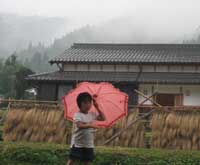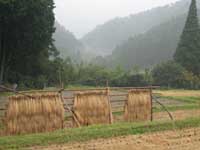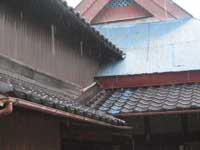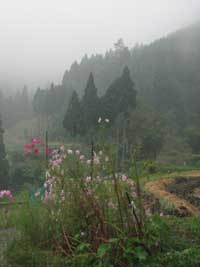VISIT TO ANOTHER WORLD
 On rainy Sunday we thought we'd go to some other kind of world than the one in the headshaking news, so we went to where everyone was smiling even in the rain, where kids played freely, where everywhere we looked was beauty and simplicity. We did this by driving north for about 45 minutes to a mountain village called Hata that we hadn't even known existed until we heard about its festival via the local grapevine.
On rainy Sunday we thought we'd go to some other kind of world than the one in the headshaking news, so we went to where everyone was smiling even in the rain, where kids played freely, where everywhere we looked was beauty and simplicity. We did this by driving north for about 45 minutes to a mountain village called Hata that we hadn't even known existed until we heard about its festival via the local grapevine.We hadn't known Hata existed because that's the way the villages founders wanted it: secrecy and inaccessibility were key factors in the village's beginning nearly
 1000 years ago. Hata is one of those villages in central Japan that were created back then in locations chosen for their remoteness. They were established by ochimusha (defeated warriors) in the aftermath of the great climactic battle of Dan-no-Ura, chronicled in the Heike Monogatari (The Tale of the Heike). Following disastrous defeat, surviving Taira clan warriors, their families and other battle stragglers fled for their lives to distant, hidden places that they'd known about here and there in central Japan - and likely had kept in mind in case of just such an eventuality - unsettled mountain fastnesses where they would not be found and hunted down, and where their descendants live still.
1000 years ago. Hata is one of those villages in central Japan that were created back then in locations chosen for their remoteness. They were established by ochimusha (defeated warriors) in the aftermath of the great climactic battle of Dan-no-Ura, chronicled in the Heike Monogatari (The Tale of the Heike). Following disastrous defeat, surviving Taira clan warriors, their families and other battle stragglers fled for their lives to distant, hidden places that they'd known about here and there in central Japan - and likely had kept in mind in case of just such an eventuality - unsettled mountain fastnesses where they would not be found and hunted down, and where their descendants live still.In this little village of some 30 families, where the locals says there are more monkeys than people, the folks were having their village festival on Sunday, an event not much advertised beyond the local area, so we left this world and went there, a beautiful secluded mountain village often used these days as the setting for many traditional-type Japanese movies, since a lot of this original beauty has been erased in modernized Japan, but these people had been isolated and self-sufficient for so long that, for example their centuries-old, lovingly arranged and maintained terraces of rice paddies were included in the book Nihon no Tanada-Hyakusen (100 Japanese Rice Terraces), the only ones in Shiga Prefecture to earn that distinction. And so Hata became famous.
 The road into the village, now a single-lane paved road along a stream between two mountain shoulders, was originally only the stream through a steep defile, the well-hidden village therefore easily defensible by only a few against an army. And so they've lived there for nearly a millennium now, along upward winding roads lined with old and new farmhouses flanked by rice paddies terraced along the natural topography, the tall trees and mountain ridges shaded into distances by the rain and mist…
The road into the village, now a single-lane paved road along a stream between two mountain shoulders, was originally only the stream through a steep defile, the well-hidden village therefore easily defensible by only a few against an army. And so they've lived there for nearly a millennium now, along upward winding roads lined with old and new farmhouses flanked by rice paddies terraced along the natural topography, the tall trees and mountain ridges shaded into distances by the rain and mist…There beside a temple grove loud with the sound of the rain the villagers were gathered in the festive way beneath canopies where many were selling local goods, salt-broiled trout and other fish, rice cakes, miso, carved gourds and other local crafts and, as a sweet for the kids, baked sweet potatoes baked on the spot.

The big event was the scarecrow contest (naturally crucial in a place even more subject to the wild than where I live) for which there were 13 entries prominently on display in a small rice field commandeered for the occasion: a startlingly impressive samurai warrior in full regalia, a leaping clown, Godzilla climbing what looked suspiciously like the Empire State building, an ostrich ingeniously fashioned of wild grasses, a glitzy peacock made of something metallic very deftly cut, that I'm sure crows hate as soon as they set eyes on it, and a few effective variations on the conventional.
We walked along up the curving road past the houses and fields, watching the scenery change with every step, then wandered back the same way, leaving much yet to be explored on other autumn days. Echo bought a broiled trout at a discount, and they added a fat salt-broiled Ayu as a bonus. On our way out one of the village elders smilingly handed us some auspicious rice cakes, one pink and one white, to take home and toast later.


















4 comments:
Hello, saw your blog website by chance and happened to see the village of Hata. I really loved the pictures of this village. Where it is exactly. I could not find it under Google map. I could find Shiga prefecture, but not Hata village.
Cheers, Francesco. Italy.
Francesco,
Go to this map and follow route 296 to where it turns white as a single lane road; right at the end of that road is (the two-character name of) Hata.
PS: Follow route 161 (on the west side of the lake) north and find 296 off to the left...
Hi Roberto, thank you very much for your indication. It's a small village isolated from other cities. It must be very beautiful. I have lived in Japan for many years, but now live and work in Italy for more than 18 years after my college days. I really miss Japan. Ciao.
Post a Comment